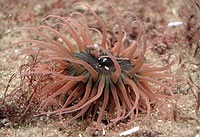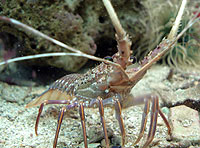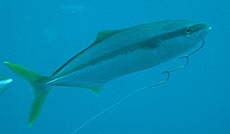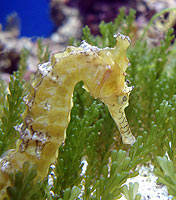What happened this year
Western Australia
Geographe Bay – ‘A Living Wonderland’
A forum on the latest cutting edge research and insights into Geographe Bay, presented by the South West Catchments Council
Geographe Bay is a special place with its north-facing bay, protected from the full effect of the winter storm fronts that sweep up from the South West.
The warming sun feeds its vast seagrass beds in the shallower water and its intricate limestone reef systems contain an intriguing variety of marine organisms. |

Anemone Image courtesy Gilbert Stokman |
| |
|
This special blend attracts people from all over, to work or spend their leisure-time in, on or near Geographe bay. However, the high growth in population and tourism in the South West is leading to increased pressure on the marine environment. Fishing, boating and ecotourism cause some of these pressures, as well as nutrient enriched run-off from residential, agricultural and industrial areas and sewerage waste disposal.
Combine these with the unknown effects of climate change and introduced marine pests it is very clear that there is a need for all of us to learn as much as we can about this living wonderland.
With this in mind, the Marine Education Officer for the South West (Gilbert Stokman from the WA Department of Fisheries, sponsored by South West Catchments Council, funded by the Federal Government) recognized the need for the general public to be given an update on the latest cutting edge research and insights into the biology and ecology of Geographe Bay. |

Western Rock lobster
Image courtesy Gilbert Stokman
|
| |
|
As a part of Sea Week 2008 celebrations, Gilbert organized a marine seminar for March 5th. About 100 educators, students, fishers, business operators and their staff, councilors, city planners, interest groups and members of the general public were treated to an exciting and inspiring series of talks that encompassed all the facets of Geographe Bay.
The presenters donated their time because they are passionate about the marine environment in Geographe Bay and its surrounds. They included:
Dr Alan Pearce from Curtin University, who gave a presentation on the Leeuwin Current and how it is a current that flows upside down and acts as a highway delivering tropical marine life to the temperate waters of Geographe Bay. |

Yellow tail with gang hooks attached
Image courtesy Russ Cocker |
Heather Taylor, the project manager of the Marine Futures project, a project that is giving us a better understanding and setting the benchmarks by mapping the bottom using the latest high tech methods. Heather outlined the dominant habitats and associated organisms in the Geographe Bay area and elaborated on the methods used for mapping.
Peter Barnes from the University of Western Australia, who is doing benchmark studies on marine communities in the South West. Peter gave a passionate and enlightening talk on the latest research of the often overlooked but important inhabitants of the seagrass meadows of Geographe Bay.
He concentrated on the invertebrates from bright yellow sea stars to iridescent blue sponges corals, ascidians, sea cucumbers. Peter highlighted the roles they play in Geographe Bay in maintaining the biodiversity and integrity of Geographe Bay - for example a sponge the size of a coffee cup filters 4000 litres of water a day! |

Marine Seminar Geographe Bay |
Dr Mike Mackie from the Department of Fisheries Research Division took the participants through an animated, interesting presentation on the latest ecological studies into some of the behavior patterns, and roles that West Australian Dhufish play in the local ecosystems in and around Geographe Bay. It is thought that an important role that the spawning Dhufish in Geographe Bay and surrounds is to supply juvenile stocks to the northern regions.
The fifth speaker was Holly Smith from the Dolphin Discovery Center, where Holly is doing her PhD through Murdoch University, examining the habitat use and population dynamics of Bottlenose dolphins. Holly has a vast experience with Blue whales, Humpback whales, Australian sea lions, New Zealand fur seals and turtles. Holly took participants on a marine mega fauna safari where she dazzled the crowd with her talk on the mammals or “warm bloods” that work rest and play in the bay.
During the break for refreshments Anna Micha, the manager of the Busselton Jetty Underwater Observatory, put on a slide show that highlighted some of the exciting marine life that lives under the jetty as well as some slides with the history of the jetty.
One of the pleasing outcomes from the seminar was the comments from a very large section of the audience about how the research findings and updates had given them new insight into Geographe Bay, how all things were interlinked and would certainly influence the way they interact with the marine environment and make them think about the impacts from terrestrial activities.
It appears that this may be the first in a series of seminars aimed at raising awareness and bridging the knowledge gap between research and the community, provided funding is available for such important events. The was feedback from participants (including the planners and councilors who make decisions that affect the coastal and marine environments) was very positive - many really enjoyed the seminar and recognized there was a need in the community for seminars like this, where the science was presented in a way that people from the community could understand and appreciate.
It is through the valuable research work by the seminar’s presenters and other researchers, that we will be armed with the knowledge to monitor and hopefully make the correct decisions so that the living wonderland called Geographe Bay can be enjoyed today, tomorrow and well into the future by us, our children and our children’s children.
Gilbert would like to acknowledge the following sponsors South West Catchments Council, Department of Fisheries, Government of Western Australia, Australian Government, MarineDiscoveryWest, University of Western Australia, Marine Futures Project, Curtin University, Murdoch University, Dolphin Discovery Center and the Busselton Jetty Underwater Observatory, without whose valuable support this seminar would not have been possible. |

Western Sea Horse
Image courtesy Gilbert Stokman |
|
|




